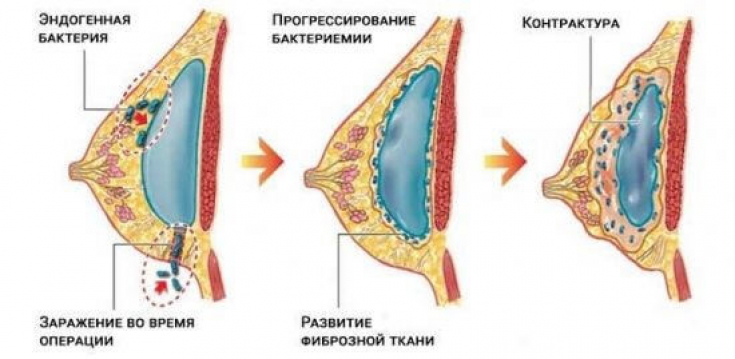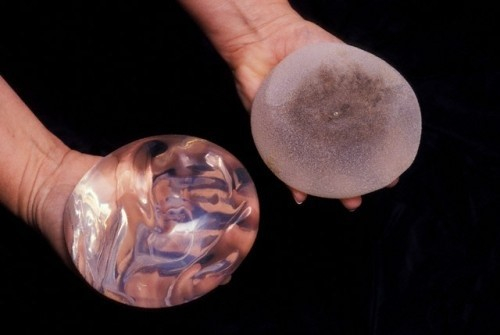Capsular contracture is the most common complication following implant breast augmentation and one of the most common reasons for reoperation.
Capsular contracture is caused by an excessive fibrotic reaction to a foreign body (implant) and has an overall incidence of 10.6%. Risk factors that were identified included:
- use of smooth implants;
- subglandular placement of implants;
- use of saline implants;
- Previous breast radiation therapy.
On estet-portal.com read how to prevent capsular contracture and how to correct this complication.
- How to reduce the risk of capsular contracture after breast augmentation
- Features of the surgical technique for the prevention of capsular contracture
- Surgical correction of capsular contracture after breast augmentation
- Medication methods for eliminating capsular contractionry
How to reduce the risk of capsular contracture after breast augmentation
Breast augmentation is one of the most frequently performed cosmetic procedures. For mammoplasty, different types of implants are used, which are usually divided according to:
- implant shape (round or anatomical shape);
- surface textures (smooth or textured);
- gel used to fill the implant (usually saline or silicone).

Silicone breast implants are currently the most popular and recognized material for breast augmentation.
Silicone gel implants, first introduced in 1961, now dominate the world market and this is reflected in the much larger range available for use. Silicone as a filler material has a number of advantages: implants are thought to act more like natural breast tissues.
also offer a number of benefits. The main advantage is that saline implants bypass fears of rupture. When such an implant with saline is ruptured, the liquid is absorbed into the body harmlessly.
Capsular contracture can be triggered by smoking and exercise Regarding the risk of capsular contracture, it has been found to occur in 20.8% of breast augmentation with saline implants, indicating a much higher risk than with silicone implants. The texture has also been found to implant surface affects the incidence of capsular contracture.
Textured implants have been found to be associated with a lower risk of clinically significant capsular contracture.

Implants with
macro-textured surfacessignificantly reduce the risk of contracture, in particular, participants in one particular study found that when using such implants, capsula mimics the feeling of natural firmness of the breast. Features of surgical technique for the prevention of capsular contracture
implant, when placed behind the pectoralis major muscle, results in a lower incidence of capsular contracture than when the implant is placed directly under the skin. However, both placements can lead to contracture.
Capsular contracture after breast augmentation: what is dangerous and how to eliminate it A recent systematic review found that the overall rates of capsular contracture with subglandular placement was 8.6%, while for submuscular placement it was only 2.8%.
This suggests that the axillary implant placement technique should be preferred in order to reduce
the risk of possible complications. Surgical correction of capsular contracture after breast augmentation
Traditionally, capsular contracture is treated surgically, although it is important to note that treatment is only indicated for grade III and IV capsular contracture.
In fact, surgical treatment is associated with a significant risk of contracture recurrence, approaching 25% in the first year, which can lead to a cascade of procedures.
The most common surgical treatmentis total capsulectomy with repositioning of the implant
.
Peculiarities of choosing implants for mammoplasty Other surgical techniques that have been discussed as strategies for treating capsular contracture include
the use of autologous fat:
- lipofilling
- to try to correct capsular contracture; fat graft
- placed in the original implant pocket along with the half implant. In addition, there is recent evidence that autologous fat transfer can be used
van to correct capsular contracture by increasing tissue vascularity peri-implant . Medicated methods for eliminating capsular contracture
Although the exact etiopathogenesis of capsular contracture remains to be elucidated
, the inflammatory responseseems to play a role in this process. Therefore, it is believed that modulating the inflammatory response with drugs may reduce the incidence of capsular contracture.
Read the most interesting articles inTelegram!
The leukotriene antagonist Zafirlukastwas used off-label to investigate whether it affects the development of contracture. Animal studies have shown that when the drug was injected around textured silicone implants, capsules formed much thinner and with lower collagen density, indicating that the drug may prevent capsular contracture.
Choosing Implants for Augmentation Mammoplasty: What Plastic Surgeons Need to Keep in Mind
Botulinum toxin Ahas been reported to be effective in reducing keloid scars. The implant capsules have been found to be histologically similar to these scars, so a recent study was conducted to see if this could reduce contracture volume or prevent it from developing. A study in rats injected with 0.5 ml (5 units) of botulinum toxin A into implant pockets showed that the capsule was reduced in thickness on histological analysis of the capsule after 6 weeks.
An anti-adhesion barrier solutiondeveloped in Korea has also been studied for its effect on reducing the development of capsular contracture. Animal studies show promising results:
thinner capsules formed;- significantly decreased amount of collagen type 1;
- there was a decrease in the number of inflammatory cells.
YouTube:






